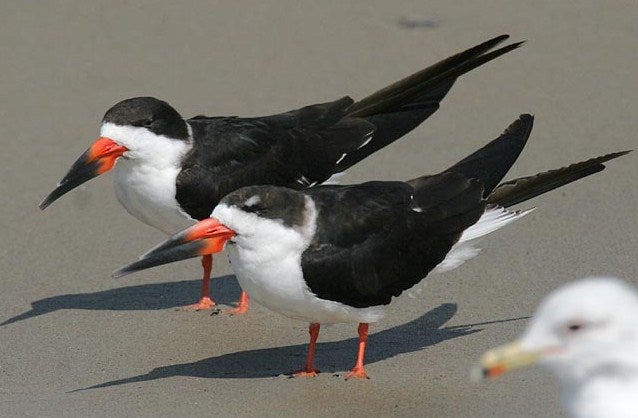SCIENTIFIC NAME:
Rynchops niger
OTHER NAMES:
Scissorbill
STATUS:
Breeder. Common in all seasons in Gulf Coast region. In other regions, occasional in fall due to storms. MODERATE CONSERVATION CONCERN.
DESCRIPTION:
The black skimmer is a striking black and white plumaged bird. Skimmers are around 18 inches in length with a near 48 inch wingspan. Adult birds have black crowns, hind necks, and backs. Wings are black on the upper surfaces and the tail has a black central stripe. Other feathered areas are white. In winter, adult birds have white hind necks. The short legs are red. Juvenile birds are brown or mottled brown where black in adults. The laterally compressed bill is black on the ends and red at the base. An unusual feature of the bill is the lower mandible being longer than the upper mandible. A typical vocalization of the black skimmer is a nasal “barking” call.
DISTRIBUTION:
Year-round in coastal Alabama, the Gulf coast, and north along the Atlantic coast into North Carolina. Breeds further north into Massachusetts. On the Pacific coast, black skimmers are found in southern California. Birds may migrate for the winter into Mexico and Central America.
HABITAT:
Found along coastal waters and beaches.
FEEDING HABITS:
Using their unusual bill configuration, birds “skim” low over the water with the lower mandible slicing through the surface. If a food item, usually a small fish, is contacted, the upper mandible snaps down capturing the prey. Fish less than five inches in length are the mainstay of a black skimmer’s diet. Shrimp have also been documented in the stomachs of skimmers.
LIFE HISTORY AND ECOLOGY:
Black skimmers nest along sandy, mostly open beaches. In Alabama, birds annually nest in Mobile County on Dauphin Island and Pelican Island with populations around 200 to 300 pairs. Black skimmers nest in colonies, often with other tern species. Birds do not build a nest but simply lay eggs into a shallow depression created in the substrate. A typical clutch is four, though one to five eggs may constitute a complete clutch. Eggs may be bluish to buff colored with heavy, dark brown blotching. Both adults incubate the eggs for three weeks before eggs start hatching. Incubation begins with the first egg laid so hatching of the entire clutch may take several days. Chicks are semi-precocial (capable of moving about when hatched) and hatch with down feathers and are able to walk about within a day or two. Adults share chick rearing duties. Skimmer chicks are about four weeks of age before fledging. Parents continue to care for the fledged birds for several weeks afterward.
Alabama populations appear stable and the species is considered of low conservation concern
REFERENCES:
Alderfer, J., ed. 2005. National Geographic Complete Birds of North America. National Geographic. 640 pp.
Gochfeld, Michael and Joanna Burger. 1994. Black Skimmer (Rynchops niger), The Birds of North America Online (A. Poole, Ed.). Ithaca: Cornell Lab of Ornithology; Retrieved from the Birds of North America Online: https://birdsoftheworld.org/bow/species/blkski/cur/introduction.
Mirarchi, R.E., ed. 2004. Alabama wildlife. Volume 1. A checklist of vertebrates and selected invertebrates: Aquatic mollusks, fishes, amphibians, reptile, birds, and mammals. The University of Alabama Press, Tuscaloosa. 209 pp.
AUTHOR:
Roger Clay, Wildlife Biologist, Alabama Division of Wildlife and Freshwater Fisheries






